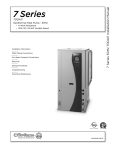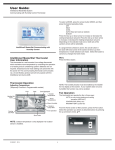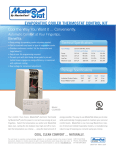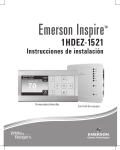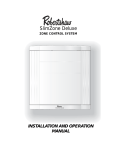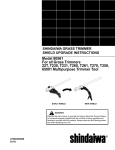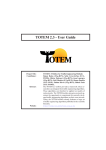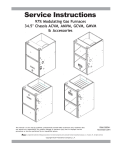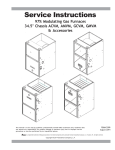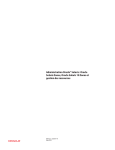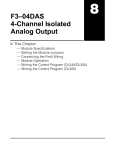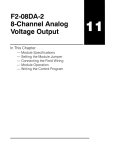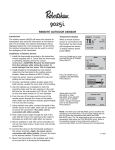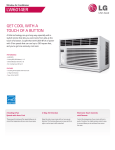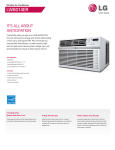Download IntelliZ one2 Installation Manual Inte
Transcript
IntelliZone2 Installation Manual Inte Comfort Zoning System Six Zone Capability Installation Information formation Damper Installation lation Thermostat Installation stallation Electrical Startup Procedures dures Wiring Schematic matic IM1578EW 07/12 INTELLIZONE2 INSTALLATION MANUAL Table of Contents General Installation Information . . . . . . . . . . . . . . . . . . . . . . . . . . . . . . . . . . . . . . . . . . . . . . . . . . . . . 5 Damper Installation . . . . . . . . . . . . . . . . . . . . . . . . . . . . . . . . . . . . . . . . . . . . . . . . . . . . . . . . . . . . . . . . 6 Electrical Wiring. . . . . . . . . . . . . . . . . . . . . . . . . . . . . . . . . . . . . . . . . . . . . . . . . . . . . . . . . . . . . . . . . . . 9 Thermostat Installation . . . . . . . . . . . . . . . . . . . . . . . . . . . . . . . . . . . . . . . . . . . . . . . . . . . . . . . . . . . . .12 IntelliZone2 Configuration . . . . . . . . . . . . . . . . . . . . . . . . . . . . . . . . . . . . . . . . . . . . . . . . . . . . . . . . . 14 IntelliZone2 cfm Design . . . . . . . . . . . . . . . . . . . . . . . . . . . . . . . . . . . . . . . . . . . . . . . . . . . . . . . . . . . 23 System Startup and Checkout. . . . . . . . . . . . . . . . . . . . . . . . . . . . . . . . . . . . . . . . . . . . . . . . . . . . . . 23 Wiring Schematic. . . . . . . . . . . . . . . . . . . . . . . . . . . . . . . . . . . . . . . . . . . . . . . . . . . . . . . . . . . . . . . . . 25 IntelliZone2 Fault Codes. . . . . . . . . . . . . . . . . . . . . . . . . . . . . . . . . . . . . . . . . . . . . . . . . . . . . . . . . . . 26 INTELLIZONE2 INSTALLATION MANUAL The IntelliZone2 Components IntelliZone2 Relay Board The IntelliZone2 relay board provides basic relay logic for the damper operation and serves as a common connection point for all IntelliZone2 thermostats and the heat pump. IntelliZone2 MasterStat The IntelliZone2 MasterStat is the master control for the system and has all of the programming for operation. It is a 4.3 in. communicating color touch screen device that also functions as a zone thermostat for Zone 1. Optional remote sensor capability is also available. IntelliZone2 ZoneStat The IntelliZone2 ZoneStat is a zone thermostat option for any of Zones 2 through 6. It has full setback capability and communicates to the IntelliZone2 system. IntelliZone2 SensorStat The IntelliZone2 SensorStat is a zone thermostat option for any of Zones 2 through 6. It has full setback capability (through the MasterStat interface only) and communicates to the IntelliZone2 system. 4 INTELLIZONE2 INSTALLATION MANUAL General Installation Information Safety Considerations Installation and Design Steps Installing and servicing heating and air conditioning equipment can be hazardous due to system electrical components. Only trained and qualified service personnel should install, repair or service heating and air conditioning equipment. When working on equipment, observe precautions in the literature, tags and labels attached to the unit, and other safety precautions that may apply. Follow all safety codes. Wear safety glasses and work gloves. 1. 2. 3. WARNING: Before performing service or maintenance operations on the system, turn off main power switches to the indoor unit. Turn off accessory heater power switch if applicable. Electrical shock could cause serious personal injury. 4. 5. 6. Delivery Information 7. 8. When the equipment is received, all items should be carefully checked against the bill of lading to be sure all crates and cartons have been received. Examine the contents for shipping damage, removing them from the cartons if necessary. If any damage is noted, the carrier should make the proper notation on the delivery receipt, acknowledging the damage. IntelliZone2 Control Panel Locate the IntelliZone2 panel in an indoor area that has enough space for service personnel to perform maintenance or repair. Provide sufficient room to make electrical connection(s). The IntelliZone2 is not approved for outdoor installation and, therefore, must be installed inside the structure being conditioned. Do not locate the control panel in areas where ambient conditions are not maintained within 45°F to 95°F and are greater than 75% relative humidity. The IntelliZone2 control panel should be mounted on or as close to the unit as possible by using the sheet metal screws provided. See Figure 1 for mounting hole locations. General rules to follow when installing a zone system: CAUTION: When installing the IntelliZone2 in a structure with fossil fuel (oil, gas, propane) appliances, it is important that both supply and return dampers are used in each zone to avoid potential back-drafting of fossil-fueled appliances. • • • • • • Figure 1: IntelliZone2 Relay Panel Mounting 9.25 in. Mounting Slots 6.00 in. Wire Access • Up to six zones on variable speed, up to four zones with dual capacity units (two with single-speed units). All dampers should be located as close to the main trunk as possible to limit the amount of pressurized trunk line and thus limit air leakage. No less than three branch runs in a zone to prevent a single branch obstruction (curtains or clothes etc.) from affecting unit airflow. Insulate and seal around rectangular dampers to prevent leakage. All dampers must be wired with 18-gauge wire. NOTE: Crimp connections should never be used on solid conductor wire. Ensure that the transformer can handle the power requirements of the system. No more than three dampers per zone. Ductboard-mounted dampers should be supported within six inches of the damper due to the weight and stress on the ductboard. Wire Access • Decide which areas of a home or office will comprise each of the individual zones. A maximum of six individual zones (four with dual capacity and two with single-speed equipment) can be chosen. Calculate loads using software or other recognized methodology. Use software to determine the equipment size and performance based on the total heating and cooling demands of the building, not the sum of the individual zone demands. Find the peak heating and cooling demands and the peak cfm required for each of the zones. Determine zone design air flow and zone size settings using IntelliZone2 Calculator software. Lay out and size the supply air ductwork and dampers. Care should be taken to avoid under sizing either the supply air systems, return air systems, or diffusers. Decide where to locate the thermostats. Install the unit and the IntelliZone2 Comfort Zoning system. Hinge Side Depth = 2.00 in. Deep with cover 10.35 in. NOTE: Use longer screws (not provided) to penetrate through drywall into stud. 5 7.75 in. INTELLIZONE2 INSTALLATION MANUAL Damper Installation Figure 2: Foam Taping Zone Damper Installing Rectangular Dampers in Metal Ductwork 1. 2. 3. 4. 5. 6. 3.75” Cut out dimensions A and B as shown in Figure 2 by using sheet metal snips. NOTE: Dimensions A and B are listed in the Dimensional Examples table. Use foam insulation tape on the top and bottom of the zone damper to prevent excessive air bypass. Also check the cross emboss for excessive air bypass (see Figure 2). Slide the zone damper into the ductwork making sure no obstructions will interfere with damper blade operation. Use the screws provided to mount the damper flange to the ductwork. Four to six mounting holes are provided as shown in Figure 3. Use drive cleats or regular duct mounting brackets to attach ductwork to joist within six inches on both sides of the damper (see Figure 3). Check damper blade operation for obstructions by holding the manual release button and rotating the damper shaft CW (Open) and CCW (Closed) 3 Wire only as shown in Figure 4. B Foam Tape (top and bottom) A Foam Seal Cross emboss for duct stiffness may cause excessive air bypass Figure 3: Mounting Damper Attach duct/damper to joist within 6" on both sides Dimensional Examples Damper Model H W A B ZDR1024 10 in. 24 in. 10 in. 3.75 in. ZDR0812 8 in. 12 in. 8 in. 3.75 in. Six Zone System Representational Layout Mounting Screws (4 places) Figure 4: Checking Damper Blade for Obstructions CW Open Rotate by hand CCW Closed 72 Manual release 72 72 72 72 2 Premier 72 6 INTELLIZONE2 INSTALLATION MANUAL Damper Installation cont. Figure 5: Insulating Rectangular Metal Ductwork Insulating Rectangular Dampers in Metal Ductwork Duct wrap insulation Insulate ductwork as shown in Figure 5. All metal must be covered. Care must be taken not to obstruct the shaft from rotating when insulating. Do not insulate the zone damper actuator. Installing Rectangular Dampers in Ductboard 1. 2. 3. 4. 5. 6. 7. Do not insulate zone damper actuator Cut out dimensions A and B by using a ductboard knife. NOTE: Dimensions A and B are listed in the Dimensional Examples table. A ductboard spacer should be installed on the end of the damper frame as shown in Figure 7 to prevent excessive air bypass. For example: A one-inch-thick, 8 in. x 20 in. ductboard and a 8 in. x 20 in. zone damper would have a one-inch gap at the end of the frame once it is installed without a ductboard spacer. Use the piece cut out for installation. Foam insulation tape should be used on the top and bottom of the zone damper to prevent excessive air bypass as shown in Figure 7. Slide the zone damper into the ductboard making sure no obstructions will interfere with damper blade operation. Tape the damper face flange to the ductboard using foil tape making sure the damper is secure and air tight as shown in Figure 8. Support the full length of the ductboard underside within six inches and on both sides of the damper as shown in Figure 8. Check the damper blade operation for obstructions by holding the manual release button and rotating the damper shaft CCW and CW (see Figure 4). Figure 7: Taping Zone Damper with Foam Tape B A Foam tape (top and bottom) Insulate between actuator and damper Duct board spacer Keep spacer clear of end bushing Figure 8: Taping Damper Flange to Ductboard Foil tape damper face to ductboard Support the full length of ductboard underside within 6” of damper 7 INTELLIZONE2 INSTALLATION MANUAL Damper Installation cont. Figure 9: Taping Round Duct to Circular Damper Insulating Rectangular Ductboard/ Metal Sleeve Three screws sealed with duct tape or mastic Care must be taken not to obstruct the shaft from rotating when insulating. Do not insulate the zone damper actuator. Manual release button Air Flow Installing Circular Dampers in Round Metal Duct 1. 2. 3. 4. 5. Crimp the end of the duct that is the supply air to damper. Insert into circular damper no more than 1.5 inches. Fasten the duct to the damper with three screws. Screws installed more than one inch from either end may obstruct damper blade rotation. Seal completely around the duct with metal duct tape or mastic to prevent air leakage as shown in Figure 10. Check the damper blade operation for obstructions by holding the manual release button and rotating damper shaft CCW and CW (3 wire only). See Figure 4. Support the duct to joist within six inches of the damper as shown in Figure 9. Figure 10: Supporting and Insulating Circular Damper Support with wide steel strap Do not insulate damper actuator 1-1/2" or 2" if in unconditioned space Insulating Circular Dampers in Round Metal Duct Insulate ductwork as shown in Figure 10. All metal must be covered to prevent condensation. Care must be taken not to obstruct the shaft from rotating when insulating. Do not insulate the zone damper actuator. Figure 11: Attaching Flexible Duct to Damper Flexible duct Slide duct 2-3’’ past damper end rib 1. 2. 3. 4. 5. Air Flow Installing Circular Dampers in Flexible Duct Slide flexible duct two to three inches over the damper pipe past the damper rib as shown in Figure 11. Fasten duct to damper with a nylon duct strap, screwing the strap to the pipe to prevent the duct from slipping off. Screws installed more than one inch from either end may obstruct damper rotation. Seal completely around the duct with metal duct tape or mastic to prevent any air leakage. Check the damper blade operation for obstructions by holding the manual release button and rotating damper shaft CW (Open) and CCW (Closed) - 3 wire only. See Figure 4. Support the damper to joist within six inches on both sides of the damper as shown in Figure 12. Clamp with duct strap. Install screw no farther than 1” from either end of damper. Figure 12: Supporting and Insulating Circular Damper Support with wide steel strap Insulating Damper Actuators Insulate the damper as shown in Figure 12. All metal must be covered to prevent condensation. When insulating, care must be taken not to obstruct the shaft from rotating. Do not insulate the zone damper actuator. 1-1/2’’ or 2’’ if in unconditioned space Do not insulate damper actuator 8 INTELLIZONE2 INSTALLATION MANUAL Electrical Wiring Wiring Damper Actuators All wiring must comply with local and state codes. Disconnect the power supply before beginning to wire to prevent electrical shock or equipment damage. All wiring should be run back to the control panel. Keep wires a minimum of 12 inches from any high voltage lines. Follow the damper wiring schematic as shown in Figure 13. Verify that damper rotation direction is correct. The 3-wire damper rotation direction is reversible with switch on front cover. Figure 13: Damper Actuator Wiring 3-Wire Damper (Indicated rotation direction is valid for switch position ‘0’ ) Zone 4 G CW Grn Open COM Blk Com CCW Red Close Minimum 18-gauge wire Damper Switch Reverse Rotation IntelliZone PCB 2-Wire Damper Zone 4 G Open COM Gray Com CCW Yellow Close Minimum 18-gauge wire IntelliZone PCB Figure 14: Actuator Wiring Damper Actuator Wiring Notes 1. 2. 3. Note: 1. Each zone must have dampers that match by manufacturer and type. 2. Each IntelliZone System must have dampers that match, either 2-wire or 3-wire. Minimum of 18-gauge thermostat wire is recommended. Use wire nuts to connect the thermostat wire to the actuator wire (solid wire to stranded wire) as shown in Figure 14. The actuator wiring should be secured using a wire tie to prevent the wires from being separated (see Figure 14). Wire Nuts 9 Strain Relief INTELLIZONE2 INSTALLATION MANUAL Electrical Wiring cont. WARNING: All wiring must comply with local and state codes. Disconnect the power supply before beginning to wire to prevent electrical shock or equipment damage. Transformer Sizing Providing adequate transformer power (VA) to supply the system is an important requirement. Each 3-wire damper requires 3.0 VA at nominal voltage. Each 2-wire damper requires 7.0 VA at nominal voltage. The standard transformer available is a 75VA with circuit breaker (Part # ZTK240). Mount the transformer onto the side of the unit’s control box on the 5 Series and on the back of the control box on the 7 Series by inserting and tightening screws (provided) into the pre-punched holes. Thread all transformer wires through the hole with bushing and follow the wiring schematic for connecting the transformer primary and secondary leads as shown in Figure 15 (5 Series) and Figure 16 (7 Series). Transformer ‘VA’ Calculation (3-wire actuator) Zone 1 Dampers Power to 2 IZ2 Dampers 6.0 VA Zone 2 Dampers Power to 1 IZ2 Dampers 3.0 VA Zone 3 Dampers Power to 2 IZ2 Dampers 6.0 VA Zone 4 Dampers Power to 3 IZ2 Dampers 9.0 VA Zone 5 Dampers Power to 2 IZ2 Dampers 6.0 VA Zone 6 Dampers Power to 3 IZ2 Dampers 9.0 VA For 208 volt operation, the red and blue transformer wires must be switched. Use wire nuts only for connections to thermostat wire. Total VA Draw 39.0 VA Figure 15: Mounting and Wiring Transformer to Control Box (5 Series shown) IntelliZone2 Relay Board C R Secondary Leads Black/White Yellow Zone Transformer 5A Fuse P18 Damper Power Blu Black e Red F1 Damper Fuse Primary Leads 10 INTELLIZONE2 INSTALLATION MANUAL Electrical Wiring cont. Figure 16: Mounting and Wiring Transformer to Control Box (7 Series shown) Zone Transformer (mounted on backside of control box) Secondary Leads IntelliZone2 Relay Board P18 Damper Power Black/White Yellow Black Red C R F1 Damper Fuse 5A Fuse Blue Primary Leads Figure 17: IntelliZone2 to 5 or 7 Series Control Wiring Wiring IntelliZone2 to the Unit WARNING: All wiring must comply with local and state codes. Disconnect the power supply before beginning to wire to prevent electrical shock or equipment damage. AID Tool Follow the wiring schematic in Figure 17 for unit control connections. Strip the wires back 1/4 inch (longer strip lengths may cause shorts) and insert the thermostat wires into the unit’s connector as shown in Figure 17. Tighten the screws to ensure tight connections. Use a minimum of 18-gauge thermostat wire for connections. Aurora ABC P7 - Zone 5 or 7 Series Heat Pump + R C - Aurora AXB + R C - A+ R C B- P17 – Heat Pump IntelliZone2 Relay Board Harness supplied with IntelliZone2 then wire nut to stat wire 11 INTELLIZONE2 INSTALLATION MANUAL Thermostat Installation Locating the Thermostats The thermostats must be located in the room or zone that each controls. Locate a thermostat about five feet above the floor. Do not locate a thermostat where it may be exposed to direct sunlight, drafts or direct supply air. Do not place a thermostat on an outside wall. Follow the same guidelines that apply with standard thermostat installation. If two or more rooms are on a single zone, locate the thermostat in a hallway or area where it can sense the return air from all rooms. Figure 18: Four Zone Thermostat Location Utility Room Bath Dining Kitchen Bath Master Bedroom Family Room Living Room Bedroom Bedroom Zone 1 Main Living Zone 2 Bedrooms Zone 3 Master Suite Not Zone 4 Basement Shown IntelliZone2 Thermostat 12 INTELLIZONE2 INSTALLATION MANUAL Thermostat Installation cont. Figure 19: Wiring the Thermostat to the IntelliZone2 Mounting and Wiring the Thermostats MasterStat S2 DX+ R C C DX- B- SensorStat A+ R C B- A+ R C B- P15 – Zone 5 3 2 1 Zone 5 Stat On IntelliZone2 Relay Board A+ R C B- P14 – Zone 4 MasterStat is always Zone 1 A+ R P11 – Zone 1 MasterStat S1 Zone 1 MasterStat IntelliZone2 Relay Board Optional Remote Sensor Position the thermostat subbase against the wall so that it is level and the thermostat wires protrude through the middle of the subbase. Mark the position of the subbase mounting holes and drill holes with a 3/16-inch bit. Install supplied anchors and secure base to the wall. Use 4-conductor 18 or 20 AWG thermostat wire unless issues with EMI are anticipated. In that situation, use 24 AWG shielded twisted pair cable grounded to “C” terminal on the relay board end. Strip the wires back 1/4 inch (longer strip lengths may cause shorts) and insert the thermostat wires into the IntelliZone2 connector as shown in Figure 19. Tighten the screws to ensure tight connections. The thermostat has the same type connectors, requiring the same wiring. Caulk the hole in the wall where the wires enter the thermostat. Zone 5 code shown Zone ID must be set for each Zone 2-6. ID cannot be confirmed on Zone SensorStat. See Zone ID Codes. NOTE: See the instructions enclosed in the thermostat for detailed installation and operation information. On 3 2 1 Zone 3 Stat ZoneStat A+ R C B- Zone 4 code shown Zone ID must be set for each Zone 2-6. ID can be confirmed on ZoneStat by pressing cancel button for 5 sec. ID shown on display. See Zone ID Codes. Zone ID Codes Zone 2 Zone 3 On Zone 4 On 3 2 1 3 2 1 Zone 6 Zone 5 On On On 3 2 1 3 2 1 3 2 1 NOTES: 1) Zone ID must be set for each Zone 2-6. ID can be confirmed on ZoneStat by pressing cancel button for 5 sec. ID shown on display. 2) Small screw driver can be used to set ID thru protective plastic skin! 3) MasterStat always Zone 1. Zone ID not necessary. 13 INTELLIZONE2 INSTALLATION MANUAL IntelliZone2 Configuration As always a 'Y' in the communication column shows that communication is OK. This will initiate communication between the IntelliZone2 system and the Aurora AXB/ABC. Aurora System and Communication Configuration of IntelliZone2 Aurora Communication Basics The Aurora Control functions around the concept of modularity and intercommunications between these boards. The communication is a 4 wire ModBus protocol. ModBus protocol is an open source protocol becoming more popular with equipment manufacturers for use in HVAC equipment. The Aurora has one ‘bus’ for the ABC, AXB, AWL, VS Drive, EEV, and thermostats. The AID Tool only plugs into the ABC AID Tool port (RJ style connector) and will not work at any other location. The AXB has 3 other independent ports for differing protocols; for IntelliZone2, ClimateTalk Components, and Communicating ECM blower motors. None of these ports comply with the ModBus protocol set up for the rest of the Aurora system. Software Versions Software versions of the IntelliZone2 MasterStat can be found in the startup screen or in the AID Tool Aurora Config screen. Software can be uploaded to the MasterStat via the USB port on the thermostat. Consult your local WaterFurnace representative or tech service for details. Wiring and Configuring the ZoneStats/SensorStats The Zone Sensors should be wired with the MasterStat on Zone 1 using standard 4-wire thermostat cable (if issues with EMI, shielded cable should be used and grounded at the ‘–‘ terminal on one end). The other zones should be added sequentially on the relay board until complete. The dip switch on the back of each ZoneStat or SensorStat should be selected for the appropriate zone number; for instance, Zone 2 stat should be selected using the DIP switch on the back for ‘off, off, off’. The ModBus communication is accomplished within the cabinet using shielded and ground cabling. This shield is most important in 7 Series applications where the VS Drive component, by its very nature, emits electro-magnetic interference and can interfere with ModBus communications. Round ferrite ‘donuts’ can be observed at various locations to aid in cleaning the communication lines. Each line is comprised of an R (+24VAC), C (common) and a ‘+’ and ‘-‘ communication line. At times the ‘R’ and ‘C’ lines may not be connected or needed. The terminals marked ‘+’ and ‘-‘ should not be switched, although damage may not occur to the boards, communication is not possible. The communication voltage and current are small therefore 24 awg wire is adequate for these communication lines and a shield is not required but recommended in high EMI environments. ZoneStats/SensorStats PCB SensorStat 3 2 1 X.XX X.XX A+ R C B- Zone 4 code shown Zone ID must be set for each Zone 2-6. ID can be confirmed on ZoneStat by pressing cancel button for 5 sec. ID shown on display. See Zone ID Codes. 'Adding' the IntelliZone2 to the Aurora system can be accomplished using the AID Tool via the 'Config Aurora' screen and scrolling to IntelliZone2 selecting and adding. ABC Y AXB Y P15 – Zone 5 On Zone 3 Stat ZoneStat Configuring the Aurora for the IntelliZone2 A+ R C B- Zone ID must be set for each Zone 2-6. ID cannot be confirmed on Zone SensorStat. See Zone ID Codes. A small LED is located next to each of the communication ports to aid in evaluating active communication at that specific port. This is true for each board. The blinking indicates transmission or receiving communication activity. Config Aurora System Dev Comm Ver A+ R C B- Zone 5 code shown An extra ‘expansion’ connector is available for connecting the AWL and other devices onto the main ABC ModBus. A+ R C B- P14 – Zone 4 3 2 1 Zone 5 Stat On IntelliZone2 Relay Board Zone ID Codes Zone 2 Add Device LOG - Logger TST - Comm Thermostat IZ2 - Intellizone2 AWL - Aurora Weblink Zone 3 On Zone 4 On 3 2 1 3 2 1 Zone 6 Zone 5 On On On 3 2 1 3 2 1 3 2 1 NOTES: 1) Zone ID must be set for each Zone 2-6. ID can be confirmed on ZoneStat by pressing cancel button for 5 sec. ID shown on display. 2) Small screw driver can be used to set ID thru protective plastic skin! 3) MasterStat always Zone 1. Zone ID not necessary. Add Device Remove Device Back Option Enter Back Option Enter 14 INTELLIZONE2 INSTALLATION MANUAL IntelliZone2 Configuration cont. • Once added to the Aurora system, the setup and configuration mode should be entered at the MasterStat by holding a finger over the IntelliZone2 logo for 5 sec. The Configuration and Setup mode will appear automatically. • • Single speed equipment Is limited to a maximum of 2 zones Dual Capacity equipment is limited to a maximum of 4 zones Variable speed equipment can have up to the maximum of 6 zones. NOTE: If the number of zones selected Is less than 6, the remaining zones will be disabled. Damper The Damper screen allows the selection of either 2 wire (spring closed) or 3 wire (power open/power closed) type. It should be noted that the MasterStat Z2TK troubleshooting harness can be useful during setup by allowing the temporary connection of the MasterStat directly at the IntelliZone2 relay board for ease of configuration or servicing. Staging Staging allows custom selection of staging. Single/dual capacity selection is different than the variable speed selections. BC R A+ P3 - MasterStat Local Z2TK Kit Use the Z2TK Harness kit to temporarily connect the IntelliZone2 MasterStat directly to the IntelliZone2 Relay Panel for ease of setup or troubleshooting. The IntelliZone2 system allows four different staging options. Once the compressor call has been initiated by a zone, the compressor will be upstaged using one of four staging options in single or dual capacity equipment: IntelliZone2 Relay Panel 3A Fuse F2 Relay Board Fuse Single and Dual Staging Normal - This “as shipped” mode will upstage the blower and compressor normally. Equipment and Number of Zones The first screen is Equipment and # of Zones. Here the total number of desired zones and the type of equipment is selected. Equipment is automatically detected. Press the up and down arrows until the desired number of zones appears. The zones should always be installed sequentially starting with the MasterStat always in Zone 1. Quicker - This mode will upstage the blower, compressor and auxiliary electric heat more expediently than “normal” mode for increased comfort. Faster - When heating, this mode will upstage the blower and auxiliary electric heat slightly faster than “quicker” mode. Cooling operation same as “quicker” mode. Faster with Time EH - This mode allows for a timed element in compressor and electric heat upstaging in 45% and 70% zones for situations in which normal staging is inadequate when heating. This staging position should be reserved for the most demanding and aggressive situations. If the heat pump is already operating in the first stage, activate second stage after a 15-minute continuous H3 zone call from a 45% or 70% zone until the zone call is reduced to a H2. Airflow will be increased to speed tap 3 or 15 INTELLIZONE2 INSTALLATION MANUAL IntelliZone2 Configuration cont. represents an approximation of the maximum heating or cooling load percentage of the zone and thus to a certain extent volume of airflow. The IntelliZone2 allows 0, 25, 45, and 70% selections. Some general rules to follow in this selection procedure are as follows: • Pick the larger percentage for major living areas such as family rooms, etc. • Pick the smaller percentage for minor living areas such as dens or bedrooms. • Pick a larger percentage if more branches are required than the load indicates due to large area per load (i.e. unfinished insulated basement). • The IntelliZone2 software should be used to aid in the selection and calculation of design cfm. • The IntelliZone2 determines modes as a proportion of the total demand. A simple example of this to begin with is a two-zone system in the cooling mode. If each zone is set at 70% we have the following scenario: Zone 1 = 50% Zone 2 = 50% 4 during this period. If the heat pump is already operating in second stage, activate third stage after a 15-minute continuous H3 zone call from a 45% or 70% zone until the zone call is reduced to a H2. Airflow will be increased to EH selection during this period. Cooling operation remains the same as “quicker” mode. Variable Speed Staging Normal - This “as shipped” mode will upstage the blower and variable speed compressor normally. Quicker - This mode will upstage the blower, compressor and auxiliary electric heat more expediently than “normal” mode for increased comfort. Generally the compressor will be upstaged 1 extra speed more than normal. Faster - When heating, this mode will upstage the blower and auxiliary electric heat slightly faster than “quicker” mode. Generally the compressor will be upstaged 2 extra speeds more than normal. NOTE: All Zone % calculations are ‘normalized using the following process: We now must determine what percentage of the total load each zone represents. To perform this operation, add the two zones together 70 + 70 = 140. One zone would then be 70/140 or 50%. Faster with Time EH - This mode allows for a timed element in compressor and electric heat upstaging in 45% and 70% zones for situations in which normal staging is inadequate when heating. This staging position should be reserved for the most demanding and aggressive situations. If the heat pump is already operating in the first stage, activate second stage after a 15-minute continuous H3 zone call from a 45% or 70% zone until the zone call is reduced to a H2. Airflow will be increased to speed tap 3 or 4 during this period. If the heat pump is already operating in second stage, activate third stage after a 15-minute continuous H3 zone call from a 45% or 70% zone until the zone call is reduced to a H2. Airflow will be increased to EH selection during this period. Cooling operation remains the same as “quicker” mode. The IntelliZone2 then reduces the total demand based upon thermostat demand. A “Y1” call in the above chart will result in one half of the zone demand in this case 1/2 of 50% for a 25% system demand. A common complaint is insufficient cooling when only one zone is calling for cooling. The IntelliZone2 will not initiate a “Y2” output to the unit until it senses a 51% total system demand (This is when the IntelliZone2 is set for normal upstaging). If the IntelliZone2 is set for quicker upstaging it drops to 41%. By this example, it will require a “Y2” call from one zone (50%) and a “Y1” call from the second zone (25%). This will give us a total system demand of 50% + 25% = 75%. System demand for three- and four-zone systems are computed in the same manner. Zone Configuration Zone configuration allows the selection of the zone size and the zone priority. The zone can be selected by touching the upper right screen text noting the zone. In this way you can cycle thru all of the active zones to view the configuration. Heating demand is determined in the same manner, but we now have a third stage instead of two for cooling. The IntelliZone2 assigns values as follows: Y1 = 40% Y2 = 80% Y3 = 100% We know from the previous example that the IntelliZone2 will initiate a “Y2” output to the compressor when it is set to normal upstaging and 51% of total demand is needed. It will issue a “W” call to the unit when there is a 90% total demand. Zone Percentage It is a common assumption that if you have a house with two zones equally divided each zone should be set at an Selecting the zone percentage can also be calculated by using the IntelliZone2 Calculator software. This percentage 16 INTELLIZONE2 INSTALLATION MANUAL IntelliZone2 Configuration cont. unless it is really needed, thus saving money. As a bonus in this mode, upon a Y1 call, the IntelliZone2 may try to precondition the zone with return air from other zones already satisfied and, in some cases, can preclude the need for energizing the compressor. equal amount, usually 70%. As can be seen in the above chart, it will take a “Y3” call from one zone as well as a “Y2” call from the second zone to obtain auxiliary heat. This is a simple example, but three- and four-zone systems are calculated in the same manner. Blower speeds are also assigned upon the percentage of system demand and a complete understanding of this process is not necessary for day-to-day decisions. As a serviceman, the temptation arises, in some instances, to influence the logic of the board by jumping “Y1” and “Y2”. While this will create a quicker response, the ductwork of that zone must be capable of handling the cfm delivered by the unit (i.e., if a “Y2” signal is given to the unit, can the ductwork handle the total cfm of the unit). Variable Speed Fan Staging - Variable Speed Fan Staging allows the ability to expand the blower levels. Options are Normal and Expanded. There are three airflow speeds assigned to a compressor speed and the airflow level is determined by the fan demand total zone %. Normal is the recommended airflow levels. Selecting Expanded will increase the highest airflow level by one level and decrease the lowest airflow level by one level from Normal. Not available for single speed or dual capacity models. When setting up a new system remember that if you have unused zones they must be set to zero. If they are not, the setting that they have will be included in the total demand preventing the other zones from operating correctly, as there will be no inputs on those zones. The IntelliZone2 allows the selection of either comfort or economy mode in each individual zone to provide maximum savings in areas that allow it (such as workshops and basements), while maintaining perfect comfort in the zones where accurate temperature is most desired (such as bedrooms and baths). Test Mode - In Test mode ‘Central Zone’ mode can be selected. In Central mode all dampers are opened and thermostat readings are taken ONLY from the Zone 1 MasterStat. This will approximate operation without a zone system (all dampers open and IntelliZone2 MasterStat temperature control) and can be useful during initial construction of the home or during service etc. Also in ‘Central Zone’ mode each damper can be individually cycled off/on to verify operation during Installation or service. It should be noted that the MasterStat Z2TK troubleshooting harness can be useful here by allowing the temporary connection of the MasterStat directly at the IntelliZone2 relay board for ease of configuration or servicing. Zone Priority Comfort Mode - A single zone call (Y1) for conditioning will engage the compressor and allow a minimal set point variation, thus providing ultimate comfort. Economy Mode - A single zone call (Y1) for conditioning will be ignored by the IntelliZone2 until either a Y2 call is initiated from the same zone or another zone calls for conditioning (Y1). This allows a slightly greater set point variation than in comfort mode. This setting prevents less important zones from energizing the compressor Aux Heat Lockout - Allows the configuration to lockout electric heat above a selected outdoor temperature. The outdoor sensor (OAT) must be installed on the IntelliZone2 Relay Board. NOTE: LAS = OAT on IntelliZone2 relay board. 17 INTELLIZONE2 INSTALLATION MANUAL IntelliZone2 Configuration cont. Data Logging - Allows the USB thumb drive to record the data every 5 seconds. Offsets Temperature Offsets: Allows the calibration of Indoor, outdoor, and remote temperature readings. Humidity Offset: Allows the calibration of humidity readings. Superboost (Variable Speed Heat Pumps ONLY) Superboost can be found under the main menu settings of the thermostat. The Superboost option temporarily enables a larger cooling capacity range. Normal cooling mode is limited to compressor speeds 1-9 and Superboost allows compressor speeds 10-12 if needed. This screen will allow the homeowner to turn the Superboost option ON or OFF. The Superboost option will be enabled, by default, for a 24-hour period of time then will automatically be disabled. NOTE: Continuous use of SuperBoost could result in overheating the ground loop. Humidity - Allows the configuration of humidify, dehumidify, both, or none. Temperature Sensors - Allows the configuration of the remote sensor to be remote only, average of remote and internal, or no remote sensor. Allows the configuration of the outdoor sensor to be zone panel, MasterStat, or no outdoor sensor. Accessories - Allows the configuration of the: Air Filter Change: Cumulative run time or calendar time Humidifier Change: Cumulative run time or calendar time UV Lamp Change: Cumulative run time or calendar time Air Cleaner Change: Cumulative run time or calendar time Dehumidification – Active - Active dehumidification will only activate during cooling operation, when cooling demand from the IntelliZone2 MasterStat is compressor speed 4 or lower and the humidity setpoint of the MasterStat is at least 5% below the actual relative humidity. The green status LED will flash code 2 when active. The compressor will ramp up and airflow will begin at a low level. Airflow is then reduced periodically until air coil temperature setpoint is reached. If coil temperature continues to drop, the airflow is increased until air coil setpoint is maintained. After 20 minutes of operation in the Active Dehumidification mode normal cooling operation will resume for 5 minutes. This cycle continues until the dehumidification setpoint is reached or IntelliZone2 MasterStat cooling demand requires greater than compressor speed 4 (normal cooling takes over). In IntelliZone2 systems, the main zone will remain open during active dehumidification. Dealer Information - Allows the input of the dealer contact information. Fault Status - Shows the last 10 IntelliZone2 system Faults (heat pump fault history is displayed at the heat pump on the AID Tool). The faults can be cleared or refreshed from this screen. Restore Defaults - Restores the factory default settings. Restart Thermostat/Upgrade Software - This allows a convenient way to restart the thermostat or upload the latest software using the USB port without killing power to the whole system. USB - Allows the import and export of data using the USB port. Importation of: Installer settings, User Settings, Program, Dealer Details Exportation of: Installer settings, User Settings, Program, Dealer Details 18 INTELLIZONE2 INSTALLATION MANUAL Blower Data Airflow Selection (Single or Dual Capacity) Airflow Selection (Variable Speed) Airflow from the Intellizone2 is communicated to the Aurora via a 'Blower Level %'. These blower levels are 55, 70, 85, and 100%. The Aurora will dictate actual airflow based upon these percentages. Below is a graphic showing how the IntelliZone2 would signal for a 55-100% blower level percent and the resulting airflow based upon the ABC setpoints of speed 5 for med and speed 8 for high in the example AID Tool setting. Notice that a blower level of 85% would result in a blower speed of 7 with these settings. All airflows are rounded to the nearest 1-12 blower speeds. Continuous blower and aux heat blower speeds are set Independently of the compressor blower speeds. Airflow from the IntelliZone2 is communicated to the Aurora via a blower Level %. These blower levels are 25, 40, 55, 70, 85, and 100%. The Aurora will dictate actual airflow based upon these percentages. Below is a graphic showing how the IntelliZone2 would signal for a 25-100% blower level percent and the resulting airflow based upon the ABC setpoints of speed 3 for low and speed 8 for high in the example AID Tool setting. Notice that a Blower level of 85% would result in a blower speed of 7 with these settings. All airflows are rounded to the nearest 1-12 blower speeds. Continuous blower and aux heat blower speeds are set Independently of the compressor blower speeds. Heating Airflow Selection (Single or Dual Capacity) Comp Stage Low Comp Stage Low Comp Stage High Comp Stage High Selected in AID Tool From IZ2 Blower Cont Low High Air Level % Speed Blower 1 2 3 4 55% 5 ---> 70% 6 85% 7 100% 8 ---> ---> 9 10 11 12 Heating Airflow Selection (Variable Speed) Selected in AID Tool From IZ2 Blwr Cont Low Hi Aux Air Level % Speed Blwr Comp Comp Heat 1 2 Aux Heat Comp Speeds Low 1&2 Selection Comp Speeds 3&4 Comp Speeds 5&6 Comp Speeds 7&8 Comp Speeds 9 & 10 Comp Speeds High 11 & 12 Selection ---> NOTES: 1) Continuous Blower activated by G only call from IntelliZone2 (selection can be anywhere) 2) Aux Heat Airflow activated by Aux or Emergency heat call (selection must be greater than high and allow proper airflow for the installed electric heat/heat pump model) 3 40% 4 55% 5 70% 6 85% 7 100% 8 9 10 11 12 In cooling a similar procedure occurs with the exception that when dehumidification reduces airflow it is a reduction as shown below. Therefore in dehumidification mode, if blower speed 5 is selected the resulting airflow will be blower speed 5, less 15%. If cooling airflow is configured to be 15% less than heating airflow then there is no difference between cooling and dehumidification cooling airflow. Continued on the next page. Cooling Airflow Selection (Single or Dual Capacity) Comp Stage Low Comp Stage Low Comp Stage High Comp Stage High 25% Selected in AID Tool From IZ2 Actual Blwr Cont Aux Low High Air Level % Blwr Spd* Speed Blwr Heat 1 2 3 4 Blwr Spd 55% 5 ---> 5 - 15% Blwr Spd 70% 6 6 - 15% Blwr Spd 85% 7 7 - 15% Blwr Spd 8 ---> ---> 100% 8 - 15% 9 10 11 ---> 12 NOTES: 1) Continuous Blower activated by G only call from IntelliZone2 (selection can be anywhere) 2) Aux Heat Airflow activated by Aux or Emergency heat call (selection must be greater than high and allow proper airflow for the installed electric heat/heat pump model) 19 ---> ---> ---> ---> INTELLIZONE2 INSTALLATION MANUAL Blower Data cont. In cooling a similar procedure occurs with the exception that compressor speed is limited to a maximum of speed 9. However compressor speed 10-12 is available for a short period of time and the resulting airflow during the ‘SuperBoost’ mode is shown below. Another exception is when dehumidification reduces airflow; it is a reduction as shown below. Therefore, in dehumidification mode, if blower speed 3 is selected, the resulting airflow will be blower speed 3, less 15%. Cooling Airflow Selection (Variable Speed) Comp Speeds 1&2 Comp Speeds 3&4 Comp Speeds 5&6 Comp Speeds 7&8 Comp Speeds 9 &10 Comp Speeds 11 & 12 Selected in AID Tool AID Reported Cont Blower Low Comp Hi Comp Blower Speed 1 2 From IZ2 Air Level % Actual Blower Speed* 25% Blower Spd 3 - 15% 3 40% Blower Spd 4 - 15% 4 55% Blower Spd 5 - 15% 5 70% Blower Spd 6 - 15% 6 Cooling Max 85% Blower Spd 7 - 15% 7 SuperBoost Only 100% Blower Spd 8 - 15% Low Selection Aux Heat ---> 8 ---> ---> 9 10 11 12 ---> NOTE: * Denotes default cooling airflow setting of 15% less than heating mode airflow. Dual or Single Capacity Heating Unit Call Variable Speed Capacity Blower Level Call (Norm) Blower Level Call (Dehumid) H1 55 or 70% na H2 85 or 100% na H2, W Aux Blower na W Aux Blower na G G Only (cont Blower) na Heating Unit Call Blower Level Call (Normal Staging Shown) Blower Level Call (Dehumid) H1 or H2 25% or 40% na H3 or H4 25% or 40% or 55% na H5 or H6 40% or 55% or 70% na na H7 or H8 55% or 70% or 85% H9 or H10 70% or 85% or 100% na H11 or H12 85% or 100% na na Cooling Unit Call Blower Level Call (Norm) Blower Level Call (Dehumid) C1 55 or 70% 55 or 70% less 15% cfm H9-H12, W Aux Blower C2 85 or 100% 85 or 100% less 15% cfm W Aux Blower na G G Only (cont Blower) G Only (cont Blower) G G Only (cont Blower) na Cooling Unit Call Blower Level Call (norm) Blower Level Call (Dehumid) C1 or C2 25% or 40% Norm less 15% cfm C3 or C4 25% or 40% or 55% Norm less 15% cfm C5 or C6 40% or 55% or 70% Norm less 15% cfm C7 or C8 55% or 70% or 85% Norm less 15% cfm C9 or C10 70% or 85% or 100% Norm less 15% cfm C11 or C12 85% or 100% Norm less 15% cfm G G Only (cont Blower) G Only (cont Blower) NOTE: C10-C12 are only available in SuperBoost mode. 20 INTELLIZONE2 INSTALLATION MANUAL Blower Data cont. 5 Series - Single Speed with 5-Speed ECM Motor Airflow (cfm) at External Static Pressure (in. wg) Motor Motor T’stat Blower Motor Speed Tap Cnct. Size HP 0 0.05 0.10 0.15 0.20 0.25 0.30 0.35 0.40 0.45 0.50 0.60 0.70 0.80 High 5 W 980 960 940 930 920 905 890 875 860 840 820 800 745 Med High 4 Y1 890 878 865 845 825 813 800 785 770 753 735 710 665 022 Med 3 9x7 1/2 830 815 800 788 775 755 735 723 710 690 670 640 600 Med Low 2 G 780 760 740 703 665 653 640 620 600 585 570 Low 1 625 593 560 535 510 495 480 455 430 410 390 High 5 1407 1381 1354 1327 1300 1267 1233 1201 1168 1131 1094 1009 Med High 4 W 1146 1134 1122 1111 1099 1085 1071 1062 1052 1042 1031 966 030 Med 3 9x7 1/2 Y1 1023 1012 1001 985 969 959 949 937 925 913 901 Med Low 2 978 962 946 934 922 907 891 882 872 858 843 Low 1 G 795 777 759 748 737 718 698 686 673 650 626 High 5 W 1530 1503 1476 1453 1429 1413 1397 1376 1355 1342 1329 1276 1231 1173 Med High 4 Y1 1413 1388 1363 1342 1321 1303 1285 1263 1240 1226 1212 1173 1016 946 036 Med 3 11 x 10 1/2 1355 1325 1294 1276 1258 1235 1212 1188 1164 1144 1123 982 909 883 Med Low 2 1336 1299 1261 1242 1222 1202 1181 1157 1132 1111 1090 937 874 830 Low 1 G 1243 1182 1121 1061 1000 964 928 856 784 744 703 647 592 High 5 1934 1910 1886 1871 1855 1827 1799 1780 1760 1747 1734 1700 1659 1617 Med High 4 W 1799 1783 1767 1744 1720 1693 1666 1649 1631 1617 1603 1560 1530 1492 042 Med 3 11 x 10 1 1694 1680 1666 1642 1617 1592 1567 1552 1537 1519 1500 1453 1421 1372 Med Low 2 Y1 1575 1560 1540 1520 1502 1487 1471 1448 1424 1409 1393 1351 1308 1266 Low 1 G 1454 1406 1358 1333 1308 1285 1261 1239 1217 1198 1179 1072 1002 988 High 5 1934 1910 1886 1871 1855 1827 1799 1780 1760 1747 1734 1700 1659 1617 Med High 4 W 1799 1783 1767 1744 1720 1693 1666 1649 1631 1617 1603 1560 1530 1492 048 Med 3 Y1 11 x 10 1 1694 1680 1666 1642 1617 1592 1567 1552 1537 1519 1500 1453 1421 1372 Med Low 2 1575 1560 1540 1520 1502 1487 1471 1448 1424 1409 1393 1351 1308 1266 Low 1 G 1454 1406 1358 1333 1308 1285 1261 1239 1217 1198 1179 1072 1002 988 High 5 W 2245 2230 2214 2194 2173 2155 2136 2120 2103 2087 2070 2032 1998 1957 Med High 4 2092 2073 2054 2035 2015 1995 1975 1958 1940 1922 1904 1880 1843 1806 060 Med 3 11 x 10 1 1951 1931 1910 1889 1868 1850 1831 1812 1793 1774 1755 1722 1688 1654 Med Low 2 Y1 1812 1796 1780 1761 1741 1718 1695 1682 1668 1651 1633 1591 1555 1518 Low 1 G 1682 1661 1640 1616 1591 1573 1555 1533 1510 1495 1480 1441 1400 1351 High 5 W 2472 2454 2435 2414 2393 2371 2349 2328 2306 2289 2271 2230 2189 2121 Med High 4 Y1 2271 2248 2225 2205 2184 2166 2147 2129 2110 2094 2078 2039 2011 1977 070 11 x 10 1 Med 3 2133 2115 2096 2072 2047 2030 2013 1996 1979 1965 1950 1909 1873 1837 Med Low 2 2008 1985 1962 1939 1915 1898 1880 1862 1843 1828 1812 1774 1742 1703 Low 1 G 1806 1784 1761 1742 1722 1696 1669 1656 1642 1625 1607 1564 1527 1490 Factory speed settings are in Bold Air flow values are with dry coil and standard filter For wet coil performance first calculate the face velocity of the air coil (Face Velocity [fpm] = Airflow [cfm] / Face Area [sq ft]). Then for velocities of 200 fpm reduce the static capability by 0.03 in. wg, 300 fpm by 0.08 in. wg, 400 fpm by 0.12in. wg., and 500 fpm by 0.16 in. wg. Highest setting is for auxiliary heat (W) and lowest setting is for constant blower (G). The “Y1” and “Y2” settings must be between the “G” and “W” settings. The gray wire is not factory wired to the motor and is tied to the wire harness. This wire can be field connected and can be used with 3ht/2cl thermostats or IntelliZone2 to deliver the required air flow for the Y2 signal. Model 0.90 1910 1767 1612 1480 1316 2033 1930 1793 1669 1443 1.00 1825 1728 1562 1433 1263 1936 1846 1748 1635 1404 6/14/12 0.90 1910 1767 1612 1480 1316 2033 1930 1793 1669 1443 1.00 1825 1728 1562 1433 1263 1936 1846 1748 1635 1404 6/14/12 5 Series - Dual Capacity with 5-Speed ECM Airflow (cfm) at External Static Pressure (in. wg) Motor Motor T’stat Blower Motor Speed Tap Cnct. Size HP 0 0.05 0.10 0.15 0.20 0.25 0.30 0.35 0.40 0.45 0.50 0.60 0.70 0.80 High 5 W 1120 1109 1097 1082 1066 1055 1044 1028 1011 1001 991 932 839 Med High 4 Y2 1020 1006 991 980 968 950 932 922 911 894 876 849 812 026 Med 3 9x7 1/2 917 906 895 884 872 854 836 824 812 792 772 754 719 Med Low 2 Y1 836 824 812 794 776 765 754 735 715 703 691 653 631 Low 1 G 735 721 707 687 666 653 640 622 603 589 574 533 High 5 W 1530 1503 1476 1453 1429 1413 1397 1376 1355 1342 1329 1276 1231 1173 Med High 4 Y2 1413 1388 1363 1342 1321 1303 1285 1263 1240 1226 1212 1173 1016 946 038 Med 3 Y1 11 x 10 1/2 1355 1325 1294 1276 1258 1235 1212 1188 1164 1144 1123 982 909 883 Med Low 2 1336 1299 1261 1242 1222 1202 1181 1157 1132 1111 1090 937 874 830 Low 1 G 1243 1182 1121 1061 1000 964 928 856 784 744 703 647 592 High 5 W 1934 1910 1886 1871 1855 1827 1799 1780 1760 1747 1734 1700 1659 1617 Med High 4 1799 1783 1767 1744 1720 1693 1666 1649 1631 1617 1603 1560 1530 1492 049 Med 3 Y2 11 x 10 1 1694 1680 1666 1642 1617 1592 1567 1552 1537 1519 1500 1453 1421 1372 Med Low 2 Y1 1575 1560 1540 1520 1502 1487 1471 1448 1424 1409 1393 1351 1308 1266 Low 1 G 1454 1406 1358 1333 1308 1285 1261 1239 1217 1198 1179 1072 1002 988 High 5 W 2245 2230 2214 2194 2173 2155 2136 2120 2103 2087 2070 2032 1998 1957 Med High 4 Y2 2092 2073 2054 2035 2015 1995 1975 1958 1940 1922 1904 1880 1843 1806 064 Med 3 11 x 10 1 1951 1931 1910 1889 1868 1850 1831 1812 1793 1774 1755 1722 1688 1654 Med Low 2 Y1 1812 1796 1780 1761 1741 1718 1695 1682 1668 1651 1633 1591 1555 1518 Low 1 G 1682 1661 1640 1616 1591 1573 1555 1533 1510 1495 1480 1441 1400 1351 High 5 W 2472 2454 2435 2414 2393 2371 2349 2328 2306 2289 2271 2230 2189 2121 Med High 4 Y2 2271 2248 2225 2205 2184 2166 2147 2129 2110 2094 2078 2039 2011 1977 072 Med 3 11 x 10 1 2133 2115 2096 2072 2047 2030 2013 1996 1979 1965 1950 1909 1873 1837 Med Low 2 Y1 2008 1985 1962 1939 1915 1898 1880 1862 1843 1828 1812 1774 1742 1703 Low 1 G 1806 1784 1761 1742 1722 1696 1669 1656 1642 1625 1607 1564 1527 1490 Factory speed settings are in Bold Air flow values are with dry coil and standard filter For wet coil performance first calculate the face velocity of the air coil (Face Velocity [fpm] = Airflow [cfm] / Face Area [sq ft]). Then for velocities of 200 fpm reduce the static capability by 0.03 in. wg, 300 fpm by 0.08 in. wg, 400 fpm by 0.12in. wg., and 500 fpm by 0.16 in. wg. Highest setting is for auxiliary heat (W) and lowest setting is for constant blower (G). The “Y1” and “Y2” settings must be between the “G” and “W” settings. Model 21 INTELLIZONE2 INSTALLATION MANUAL Blower Data cont. 5 Series - Single Speed with Variable Speed ECM Blower Speed Settings with IntelliZone2 Blower Level Percentages 3 4 5 6 7 8 9 10 11 1100 1200 1300 1400 1500 850 1000 1550 036 0.50 L 55% 70%-85% H 100% G Aux 1100 1300 1500 1600 036 1800 1950 2100 2200 800 1000 0.75 L 55%-70% H 85%-100% w/1hp* G Aux 1150 1250 1350 1450 1550 650 800 900 1050 1600 042 0.50 L 55% 70% 85% H 100% G Aux 1200 1400 1600 1700 1850 042 800 900 1000 2000 2200 2300 0.75 L 55%-70% H 85%-100% w/1hp* G Aux 1250 1350 1450 1550 650 800 900 1050 1150 1600 048 0.50 L 55% 70%-85% H 100% G Aux 1400 1600 1700 1850 048 800 900 1000 1200 2000 2200 2300 0.75 L 55%-70% H 85%-100% w/1hp* G Aux 1500 1750 1950 2100 2300 800 950 1100 1300 2325 060 0.75 L 55% 70%-85% H 100% G Aux 1500 1750 1950 2100 2300 800 950 1100 1300 2325 070 0.75 L 55% 70%-85% H 100% G Aux Blower level percentages are shown with factory recommended blower speed settings Factory settings are at recommended G-L-H-Aux speed settings L-H settings MUST be located within boldface CFM range “Aux” is factory setting for auxiliary heat and must be equal to or above the “H” setting as well as at least the minimum required for the auxiliary heat package “G” may be located anywhere within the airflow table CFM is controlled within 5% up to the maximum ESP Max ESP includes allowance for wet coil and standard filter Model Max ESP 1 650 2 750 12 2400 2400 6/8/12 5 Series - Dual Capacity with Variable Speed ECM Blower Speed Settings with IntelliZone2 Blower Level Percentages 4 5 6 7 8 9 10 11 700 800 900 1000 600 1100 1200 026 0.50 L 55% 70%-85% H 100% Aux 1100 1200 1300 1400 1500 1550 650 750 1000 038 0.50 L 55%-70% H 85%-100% G Aux 1100 1300 1500 1600 038 800 1000 1800 1875 1925 2000 0.75 L 55%-70% H 85%-100% w/1hp* G Aux 1250 1350 1450 1550 650 800 900 1050 1150 1575 049 0.50 L 55% 70%-85% H 100% G Aux 1400 1600 1700 1850 049 800 900 1000 1200 2000 2200 2300 0.75 L 55%-70% H 85%-100% w/1hp* G Aux 1500 1750 1950 2100 2300 800 950 1100 1300 2325 064 0.75 L 55% 70%-85% H 100% G Aux 1500 1750 1950 2100 2300 800 950 1100 1300 2325 072 0.75 L 55% 70%-85% H 100% G Aux Blower level percentages are shown with factory recommended blower speed settings Factory settings are at recommended G-L-H-Aux speed settings L-H settings MUST be located within boldface CFM range “Aux” is factory setting for auxiliary heat and must be equal to or above the “H” setting as well as at least the minimum required for the auxiliary heat package “G” may be located anywhere within the airflow table CFM is controlled within 5% up to the maximum ESP Max ESP includes allowance for wet coil and standard filter Model Max ESP 1 2 400 3 500 G 850 12 2400 6/8/12 7 Series - Variable Speed with Variable Speed ECM Model Max ESP 036 0.50 036 w/1hp* 0.75 048 0.75 060 0.75 Speed 1 285 480 475 400 Speed 2 380 G 565 G 620 G 600 G 7 Series Blower Speed Settings with IntelliZone2 Blower Level Percentages Speed 3 Speed 4 Speed 5 Speed 6 Speed 7 Speed 8 Speed 9 Speed 10 525 675 815 980 1100 1220 1330 1440 L 25% 40% 55% 70% 85% H 100% 665 761 870 1000 1100 1200 1300 1410 L 25% 40% 55% 70% 85% H 100% 730 850 1020 1140 1270 1400 1520 1650 L 25% 40% 55% 70% 85% H 100% 830 1050 1230 1400 1560 1700 1870 2010 L 25% 40% 55% 70% 85% H 100% Speed 11 1540 Aux 1520 Aux 1790 Aux 2140 Aux **VS Compressor 1-2 3-4 5-6 7-8 9-10 11-12 Speed Blower level percentages are shown with factory recommended blower speed settings ** VS Compressor speed is given for the factory default cfm settings. When the cfm default settings are changed it will change the relationship to the compressor speed that is shown in the table. In cooling mode compressor speeds 10-12 are only available when SuperBoost mode is selected at the thermostat. * optional 1 HP ECM Factory speed settings are at recommended G, L , H and Aux positions “G” may be located anywhere within the airflow table “L” setting should be located within the boldface CFM range “H” setting MUST be located within the shaded CFM range “Aux” setting MUST be equal to or greater than the minimum allowable CFM for the auxiliary heater kit (see auxiliary heat ratings table) CFM is controlled within 5% up to the maximum ESP Max ESP includes allowance for wet coil and standard filter 22 Speed 12 1575 1630 1925 2265 6/7/12 INTELLIZONE2 INSTALLATION MANUAL IntelliZone2 CFM Design Model NS030 NS036 NS042 NS048 NS060 NS070 ND026 ND038 ND049 ND064 ND072 NV036 NV048 NV060 Max CFM 1000 1200 1300 1500 1800 2000 800 1200 1500 1800 2000 1500 1800 2100 Zone Design CFM 700 850 900 1000 1100 1100 600 600 800 950 1100 300 450 450 CFM Percentage 50 50 50 50 50 50 40 40 40 40 40 20 20 20 System Startup and Checkout It should be noted that the MasterStat Z2TK troubleshooting harness can be useful during startup by allowing the temporary connection of the MasterStat directly at the IntelliZone2 relay board for ease of configuration or servicing. Damper and Continuous Blower Checkout 1. 2. 3. Before powering the unit, check the following: • • • • • • Fuses, breakers and wire size are correct. Low voltage wiring has been completed. MasterStat has been configured correctly. Thermostats are wired and DIP switches are set for proper zone #. Blower speed has been set on the AID Tool. Aurora control is configured for IntelliZone2. 4. 5. 6. 7. Figure 25: Checking the Shaft Position Indicator Damper Open Damper Closed CCW CW Rotate by hand Push the “Fan” button to the ON position on all thermostats. (alternate method shown in the note below) All dampers should start to open immediately. The blower should come on continuous fan speed and should illuminate the “G” LED only; all other fan speed LEDs should be off. After approximately 90 seconds, all IntelliZone2 dampers should be completely opened. Check the shaft position indicator on all damper actuators as shown in Figure 25. Push the “Fan” button to the OFF position on all thermostats. The blower and the “G” LED should cycle off. All dampers should start to close immediately. After approximately 90 seconds, all dampers should be completely closed. Check the shaft position indicator on all damper actuators shown in Figure 25. NOTES: To cycle dampers open and closed, access the ‘Test Mode’ Screen in the Installer Setup mode on the IntelliZone2 MasterStat. Once here each damper can be cycled individually by pushing the specific zone damper button to check for proper operation. “Central Zone” mode can also be used to open all dampers. Manual Release Button Shaft End Position Indicator 23 INTELLIZONE2 INSTALLATION MANUAL System Startup and Checkout cont. In the following procedure, check for proper calls on the Status Screen. Blower Speed Tables Single or Dual Capacity Heating Unit Call System Checkout 1. 2. 3. 4. 5. 6. 7. 8. 9. 10. 11. 12. 13. 14. 15. Set all of the zone thermostats to the cooling mode. Reduce the cooling set point to 2° below the actual zone temperature on all thermostats. First stage cooling should energize after a delay. Be sure the compressor and blower are activated. Check the fan speed LEDs and compare to the Blower Speed tables. Decrease the cooling set point two more degrees and check to see that the fan speed increases and second stage cooling is energized (Y1, Y2, and O LEDs). Check the fan speed LEDs and compare to the Blower Speed tables. Adjust the thermostats until the temperature displayed is 5° higher than the actual temperature on all thermostats. The call for cooling should be canceled after a delay. Set all of the zone thermostats to the heating mode. Increase the heating set point to 2° above the actual zone temperature on all thermostats. After a delay, the unit should start up in the first stage heating mode (H1). Check the fan speed LEDs and compare to the Blower Speed tables. Increase the heating set points two more degrees and check to see that the fan speed increases and second stage heating is energized (H2). Check the fan speed LEDs and compare to the Blower Speed table. Increase the heating set point to 4° above the actual zone temperatures. Be sure the auxiliary heat is energized and the fan speed increases (Y1, Y2, and W). Check the fan speed LEDs and compare to the Blower Speed tables. Set system to maintain desired comfort level. Instruct the owner/operator of correct thermostat and system operation. Fill out and forward all warranty registration papers to WaterFurnace. Blower Level Call (Norm) Blower Level Call (Dehumid) H1 55 or 70% N/A H2 85 or 100% N/A H2, W Aux Blower N/A W Aux Blower N/A G G Only (Cont Blower) N/A Cooling Unit Call Blower Level Call (Norm) Blower Level Call (Dehumid) C1 55 or 70% 55 or 70% less 15% cfm C2 85 or 100% 85 or 100% less 15% cfm G G Only (Cont Blower) G Only (Cont Blower) Variable Speed Capacity Heating Unit Call Blower Level Call (Normal Staging Shown) Blower Level Call (Dehumid) N/A H1 or H2 25% H3 or H4 40% N/A H5 or H6 55% N/A H7 or H8 70% N/A H9 or H10 85% N/A H11 or H12 100% N/A H9-H12, W Aux Blower N/A W Aux Blower N/A G G Only (Cont Blower) N/A Cooling Unit Call Blower Level Call (Norm) Blower Level Call (Dehumid) C1 or C2 25% 25% less 15% cfm C3 or C4 40% 40% less 15% cfm C5 or C6 55% 55% less 15% cfm C7 or C8 70% 70% less 15% cfm C9 or C10 85% 85% less 15% cfm C11 or C12 100% 100% less 15% cfm G G Only (Cont Blower) G Only (Cont Blower) IntelliZone2 Configuration Once added to the Aurora control system, the setup and configuration mode should be entered at the MasterStat by holding a finger on the IntelliZone2 logo for 5 seconds. The Configuration and Setup mode will appear automatically. NOTE: Unit check out can be accomplished by going to the Test Mode screen at the MasterStat and selecting Central Zone. The system will be controlled only by the MasterStat. Any time superheat and subcooling is being checked, the zone system must be in the central zone mode. 24 INTELLIZONE2 INSTALLATION MANUAL Wiring Schematic For Temporary Config or T-Shoot Z2TK Kit BC R A+ P3 – MasterStat Local IntelliZone2 System IntelliZone2 Relay Board Damper Transformer 5 or 7 Series Heat Pump Note: Shorting a thermostat R/C input will blow the ABC fuse not this fuse. P16 – Zone 6 P15 – Zone 5 A+ R C B- NO P14 – Zone 4 3 2 1 SensorStat A+ R C B- NO Zone ID must be set for each Zone 2-6. ID cannot be confirmed on Zone SensorStat. See Zone ID Codes. Zone 3 Stat On 3 2 1 ZoneStat A+ R C B- A+ R C B- NO NO Com P9 Zone 5 Dmpr NO Open Com NC Close P8 Zone 4 Dmpr NO Open Com NC Close P7 Zone 3 Dmpr NO MasterStat is always Zone 1 A+ R C B- Light emitting diode - Green G Internal junction Com Close Open Screw Terminal Strip Relay Contacts N.O., N.C. Wire nut 2 P P5 Zone 1 Dmpr NO B Y G R Com 1-Com Close 2-Close P1 LAS – Outdoor Air Sensor G 2-Wire Damper Open Drive Close/ Spring Open TSU02 Optional Outdoor Temp Sensor Zone ID Codes Legend Low voltage wiring Com NC Zone 2 Zone 4 Zone 6 Drive Open/ Drive Close Close Zone 1 Zone 3 Zone 5 Power/ G G G Com/ Heating Cooling Fan Status G 1-Com 2-Close Open NC G Com Close P6 Zone 2 Dmpr NO NO 3-Wire Damper 3-Open Open NC P11 – Zone 1 MasterStat MasterStat S1 S2 DX+ R C DX- Optional Remote Sensor Zone 1 MasterStat Zone ID must be set for each Zone 2-6. ID can be confirmed on ZoneStat by pressing cancel button for 5 sec. ID shown on display. See Zone ID Codes. Black - Com Close Zone 3 code shown A+ R C B- Blue – 240V Red – 208V 75VA kit mounted in heat pump (PN# ZTK240) Open Zone 5 code shown A+ R C B- Black/White Yellow P10 Zone 6 Dmpr NO NC P13 – Zone 3 Zone 5 Stat On NO P12 – Zone 2 Harness Supplied with IntelliZone2 then wire nut to stat wire P18 F1 Damper Damper Power Fuse C R 5A Fuse 3A Fuse Aurora AXB A+ R C B- Microprocessor and other Components F2 Relay Board Fuse P17 – Heat Pump A+ R C B- + R C - + R C - 24V P7 - Zone Aurora ABC AID Tool 3 1 Zone 2 Zone 4 On 3 2 1 Polarized connector Fuse Zone 3 On 3 2 1 Zone 6 Zone 5 On On On 3 2 1 3 2 1 3 2 1 NOTES: 1) Zone ID must be set for each Zone 2-6. ID can be confirmed on ZoneStat by pressing cancel button for 5 sec. ID shown on display. 2) Small screw driver can be used to set ID thru protective plastic skin! 3) MasterStat always Zone 1. Zone ID not necessary. NOTE: This drawing is for visual reference for wiring and configuring a zone. Do not skip zones as shown here. Zones MUST be wired in numerical sequence. 25 4/18/12 INTELLIZONE2 INSTALLATION MANUAL IntelliZone2 Fault Codes The following are IntelliZone2 fault codes that can appear on the IntelliZone2 relay board LEDs and MasterStat. All Aurora control errors will be displayed on the MasterStat as “Exx” (xx equals error number) style and fault information can be found in AID Tool and Aurora Control literature. Zone 5 Heating Cooling Fan Zone 2 Zone 4 Zone 6 Alarm/ Status Power/Com LED Codes Flash Code On Flashing Code 1 Code 2 Code 3 Code 4 Code 5 Description No Faults Communications Error No Damper Power Voltage < 19 V Voltage <16 V OAT Shorted OAT Open ZONE LED Codes Flash Code Off On Flashing Description Damper Closed Damper Open Damper Moving Other LED Codes LED Code Heat On Cool On Fan On Description Heating Mode Cooling Mode Fan Only Mode IZ2 MasterStat Errors Code Z1-1 Z1-2 Z1-3 Z1-4 Z1-5 Z1-6 Z1-8 Z1-9 Z1-10 Z1-11 Z1-12 Z1-13 Z1-14 Z1-15 Z1-97 Z1-98 Z1-99 Z1-100 Z1-101 Z1-102 IZ2 Sensor Errors (displayed on Master Stat) Code Z*-4 Z*-6 Z*-8 Z*-9 Z*-10 Z*-11 Z*-14 Z*-15 Z*-16 Z*-17 Z*-19 Z*-20 Description Humidity Temp Sensor Open Humidity Temp Sensor Shorted Outdoor Temp Sensor Error Humidity Reading too Low Humidity Reading too High Humidity Sensor Failure Remote Room Sensor Error Primary Temp Sensor Open Primary Temp Sensor Shorted Temp Reading Too Low Temp Reading Too High AXB Control no Communications Low Voltage under 19 VAC Low Voltage under 16 VAC IntelliZone2 Panel no Communications Zone 2 Sensor no Communications Zone 3 Sensor no Communications Zone 4 Sensor no Communications Zone 5 Sensor no Communications Zone 6 Sensor no Communications (displayed on Master Stat) Description Zone Sensor Control Failure Zone Sensor Temperature Reading Difference Primary Temp Sensor Shorted Primary Temp Sensor Open Secondary Temp Sensor Shorted Secondary Temp Sensor Open Temp above 99 degF Temp Below 40 degF Temp 2 above 99 degF Temp 2 below 40 degF Low Voltage below 19VAC Low Voltage below 16VAC IZ2 Panel Errors Description ZP-1 No Damper Power ZP-2 Low Voltage Below 19 VAC ZP-3 Low Voltage Below 16 VAC ZP-4 OAT Sensor Shorted ZP-5 OAT Senser Open NOTE: Example: ZP-4 = Zone Panel OAT Sensor Shorted NOTE: E Codes diplayed on the IntelliZone2 MasterStat originate from the heat pump. i.e. “E11 = Freeze Detection Sensor Error” TSU02 Optional Outdoor Temp Sensor LAS = OAT Use the Z2TK Harness kit to temporarily connect the IntelliZone2 MasterStat directly to the IntelliZone2 Relay Panel for ease of setup or troubleshooting. NOTES: 1) Where * equals the number of the zone. 2) Example: Z3-4 = Zone 3 Sensor Control Error 26 BC R A+ (on Master Stat) Code P1 P3 - MasterStat Local Zone 3 Z2TK Kit Zone 1 IntelliZone2 Relay Panel 3A Fuse F2 Relay Board Fuse Manufactured by WaterFurnace International, Inc. 9000 Conservation Way Fort Wayne, IN 46809 www.waterfurnace.com Product: Type: Size: Document: IntelliZone2 Comfort Zoning System Six Zone Capability Installation Manual ©2012 WaterFurnace International, Inc., 9000 Conservation Way, Fort Wayne, IN 46809-9794. WaterFurnace has a policy of continual product research and development and reserves the right to change design and specifications without notice. *IM1578EW* IM1578EW 07/12




























